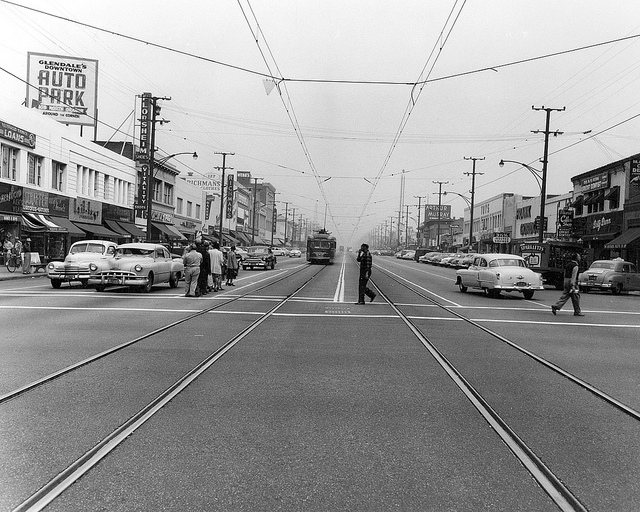5002: Perfection on the Eve of Destruction
By Ralph Cantos
The ever dependable no. 5002 rolls down Brand Boulevard as it approaches waiting passengers on June 10, 1955.
In just nine days all this PERFECT street trackage, the beautiful SP style catenary will, for all practical purposes, be scrap metal. The PCCs and Hollywood cars operating along Brand Boulevard must have provided the smoothest riding experience of any rail line in the United States at the time. How anyone in their right mind could have allowed the conversion of this excellent rail line to bus operation is anyone guess.
MY GUESS: a dirty, backroom political deal between Metropolitan Coach Lines management and city officials of Glendale.
When Jesse L. Haugh purchased the Pacific Electrics passenger service in October of 1953, the VERY FIRST thing he did was to announce his intentions to abandon ALL of the remaining former PE rail lines. The cities of Burbank and Glendale formed a united front to block any attempt on the part of MCL to convert the Burbank rail line to “stink buggy” operation. Then, without warning, the Mayor of Glendale, J. M. Lawson, stabbed the City of Burbank in the back, and dropped its opposition to the rail abandonment. HOW could something like this happen? The Burbank Line was in PERFECT condition. It was rebuilt from end to end, top to bottom in 1940.
The near-new PCCs had decades of service life remaining. The forever-young Hollywood cars were in virtually new condition. Had the line not been abandoned, it could have lasted well into the late 1980s in its 1955 condition. Today’s Red Line Subway passes within 50 feet of the PE Subway on Hill Street at 4th. The now building Downtown Rail Connector could have been incorporated into the Glendale Line.
It would have been a commuter’s utopia. All this wonderful excellent “might have been” commuter rail was flushed down the toilet by the “we don’t give a damn” mentality of the 1950s.
So now, transit experts, try as they might, must figure a way to put the Pacific Electric back together again at a cost of hundred of millions, if not, billions of our tax dollars.
GOOD LUCK!
Ralph Cantos Collection



I’ve been saying this for years! Unfortunately, you are preaching to the choir I’m afraid.
I think one other thing we have to keep in mind was the spirit of the times. In the late 1940s and early 1950s, in the economic boom after WW2, the car was the future. Streetcars were a thing of the past to many minds. Cars meant freedom for the first time for millions of people. The freeways were being constructed everywhere across Los Angeles and the country as a whole. All eyes were forward. I remember relatives reacting with amazement when I asked them about their memories of the PE when I was a kid in the 1970s. Their responses were “the PE? that old smelly thing that blocked the street for our new car?”
It’s easy now to blame a “conspiracy.” But that “conspiracy” very much reflected what the public if not the company wanted.
We need to keep that in mind as we view the slow, steady rebuilding of public transit in the LA basin.
As the Exposition line gets built out we need to remember that the when the 10 was young we all know what they preferred.
Not only were the freeways spreading in all directions, gas was 22 to 26 cents a gallon and folks could buy a useable car for $100 or so. No worries about passing a smog test either. Add to this the relative ease of getting a driver’s license and no wonder automobiles predominated. There was also the fact that PE was basically a “radial” system. For example, going from North Hollywood to downtown Burbank is about four miles by city streets, but 25 miles by Red Car into Subway Terminal and back. You might save a few miles by transferring at Echo Park, but it’s still the long way around. Going from Monrovia to El Monte was a similar situation. One could probably walk from Glendora to Covina faster than going into Valley Jct. on the PE and then back tracking on the San Bernardino line.
What is painfully obvious in the above photo is that Brand Blvd. (the rail line’s main route through Glendale) was in excellent shape and could have lasted for a number of years. Mr. Cantos is correct to point out the shenanigans of greed and stupidity, which eliminated this and other rail lines, while an increasingly car-centric public looked the other way. The real folly in all this is the millions of taxpayer dollars spent to recreate something that once existed once in L.A. and elsewhere in abundance.
What is painfully obvious in the above photo is that Brand Blvd. (the rail line’s main route through Glendale) was in excellent shape and could have lasted for a number of years. Mr. Cantos is correct to point out the shenanigans of greed and stupidity, which eliminated this and other rail lines, while an increasingly car-centric public looked the other way. The real folly in all this is the millions of taxpayer dollars spent to recreate something that once existed in L.A. and elsewhere in abundance.
What is painfully obvious in the above photo is that Brand Blvd. (the rail line’s main route through Glendale) was in excellent shape and could have lasted for a number of years. Mr. Cantos is correct to point out the shenanigans of greed and stupidity, which eliminated this and other rail lines, while an increasingly car-centric public looked the other way. The real folly in all this is the millions of taxpayer dollars spent to recreate rail lines that once existed once in L.A. and elsewhere in abundance.
notice that on most streets where PE tracks were, the rails were off set to make automobile driving easy going.
Looks like a smoggy day, back when your eyes stung like crazy and tears ran down your face.
Wow! Head knocker…I think I bought my first suit from Richman’s on Brand. Wonder who got that. While Glendale-Eagle Rock did serve as a smog corridor between the two big valleys, not all haze was a choker. Given the June date (end of spring and school year), there were fogs that rose from the surrounding agricultural belts during the night and holding on through the morning until the sun did its’ job on them. As time passed and houses spread further out, these fogs were best seen beyond and south of Pomona-Ontario (in places like Mira Loma) where Alfafa was a smell rather than a comic character. July and August was when the really nasty smog sting set in, and if you had to keep in shape for track or cross-country your lungs felt like they were going to explode. So you ran at night in the dark on the worst days. Head north towards the foothills and the cooling breezes was a good bet.